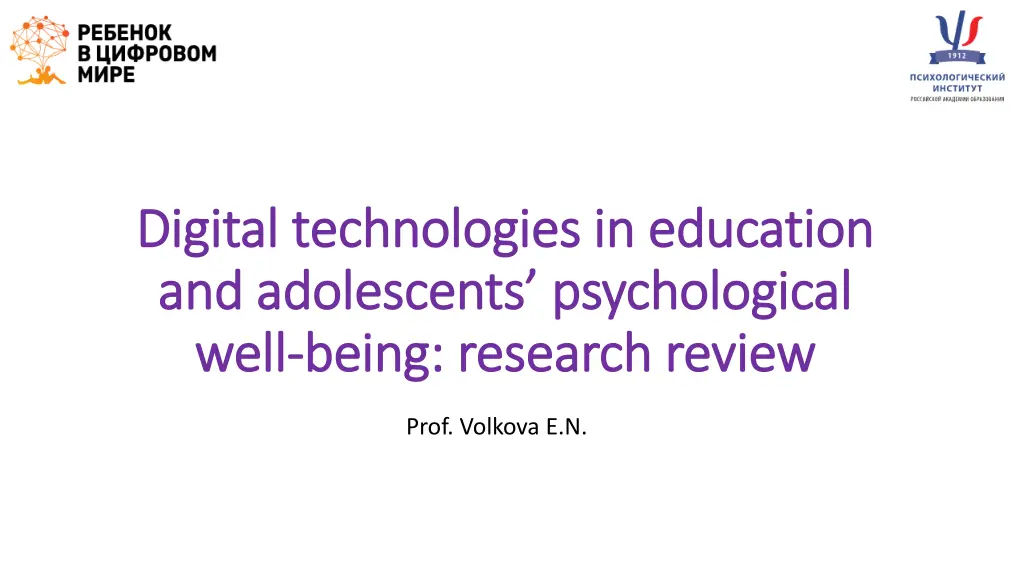
Digital Technologies in Education and Adolescent Wellbeing: Research Review
Exploring the impact of digital technologies on adolescent psychological well-being, this research review delves into the devices and data used in education, the importance of digital literacy, and the effects of screen time on adolescents' engagement, motivation, and happiness. It highlights the significance of balancing digital activities for optimal well-being in the digital sphere.
Uploaded on | 1 Views
Download Presentation

Please find below an Image/Link to download the presentation.
The content on the website is provided AS IS for your information and personal use only. It may not be sold, licensed, or shared on other websites without obtaining consent from the author. If you encounter any issues during the download, it is possible that the publisher has removed the file from their server.
You are allowed to download the files provided on this website for personal or commercial use, subject to the condition that they are used lawfully. All files are the property of their respective owners.
The content on the website is provided AS IS for your information and personal use only. It may not be sold, licensed, or shared on other websites without obtaining consent from the author.
E N D
Presentation Transcript
Digital technologies in education Digital technologies in education and adolescents psychological and adolescents psychological well well- -being: research review being: research review Prof. Volkova E.N.
Digital technologies in education Digital technologies in education Devices: PC and laptops; smartphone and tablets; bords and screens; cameras and monitors Data: lectures, presentations; interactive tasks and tests; digital information sources, documents and tables; programs Data exchange: parental and child chats; intraclass networks; personal space in social network Data processing: digital grade book; timetable tools; online platforms; algorithms and AI Data protection: personal data; hacking
Wellbeing in digital sphere Wellbeing in digital sphere Screen Time Digital Literacy Well Well- -being in adolescence being in adolescence (Kern et al, 2016) Engagement motivation and interest to activities Perseverance achieving goals Optimism hope and positive attitude Connectedness deep and caring connection Happiness long-turn life satisfaction
Screen time Screen time Excessive screen time is connected to irritation, bad mood, physical health, cognitive development, social adaptation and academic achievement (Marsh et al, 2009; Domingues- Montanari S. , 2017; Reid Chassiakos, 2016; Canadian Paediatric Society DHTFOO, 2017). 1) On Weekdays Replaces other activities (Fletcher et al. 2003) Sleep deprivation (Ram rez et al. 2021; Peiro -Velert et al. 2014) Impede study (Junco, 2012; Poulain et al. 2018; Paulich et al. 2021) 2) Type of activity (Przybylski & Weinstein, 2017) Video games and browsing vs Watching video and computer- related time No negative effects when used moderately No screen time can also lead to unhappiness (Park, 2015)
Digital Literacy Digital Literacy Digital literacy (DL) is a set of skills of using networks and digital devices, navigating and searching information, creation and production of content, communication and interaction online (Helsper et al., 2020) DL can protect from online threats (Livingstone et al., 2015) and harmful behavior online (Bernadas, Soriano, 2019; Vandoninck et al.,2013; Wegmann et al., 2015) DL helps teenagers to overcome consequences of online harm (Staude-M ller et al., 2012) DL is connected to decision-making (Hatlevik et al., 2015; Helsper et al., 2020; Vissenberg et al., 2022) Wellbeing is influenced by DL (Livingstone et al., 2023) DL is connected to professional choice (Christoph et al., 2015; Kaarakainen, 2019; Weston et al., 2019) BUT higher risk of harmful behavior (Leung, Lee, 2012; Livingstone, Helsper, 2010), more likely to cyberbully (Kumazaki et al. , 2011), Internet dependency (Leung, Lee, 2012), hacking (Holt et al, 2012), digital self-harm (Erreygers et al., 2022)
Well Well- -being in adolescence being in adolescence: : happiness happiness Relation of happiness and use of digital tech is inconsistent (Vuorre et al., 2021). Can be connected to short-term happiness rather than long- term (Dienlin, Johannes, 2020). Happiness is connected to screen time factor, unhappiness correlates with excessive screen time (Hall, 2019; Bozzola ,2019 ), negative emotion verbalization (Hall, 2018), communication characteristics (Shen, Williams, 2011). Unhappiness can correlate with not spending time on Internet (Park, 2015; Twenge, 2019), especially when it is used for communication (Gross et al.,2002).
Well Well- -being in adolescence being in adolescence: : flourishing flourishing Online happiness is not associated with real-world contentment (Wang et al.,2015) - multiple digital personas Unrealistic expectations and goals (Krogh, 2023)and social comparison (Longobardi et al., 2020) is associated with negative feelings. Association with study motivation is ambiguous (Hietaj rvi, 2019) Digital environments is source of fulfillment (Bitto et al., 2023), positive feedback (Ito et al., 2010; Iftikhar et al., 2019) and social and expert support (Radovic et al., 2018).
Open question Open question Screen time Screen time + + Digital Digital Literacy Literacy + + Well Well- -being being ? ?
Thank you for attention! Prof. E.N. Volkova Leading Researcher Child Psychology and Digital Socialization Laboratory Psychological Institute of Russian Academy of Education Moscow envolkova@yandex.ru
